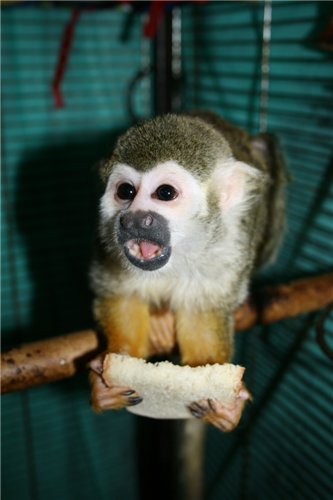
Common squirrel monkey(Saimiri sciureus)
Phylum —chordata
Class — mammalia
Order — primates
Family — cebidae
Genus –saimiri
Appearance
This animal’s average size is about 25 to 35 cm, with a tail of 35 to 42 cm length. It is 750 to 1100 gm in weight. Its coat is short and yellowish-orange in color, with a black mouth and white ears and throat. This characteristic has earned it the name death’s head monkey. There are also species of black coat monkeys.
Habitat
Common squirrel monkeys are endemic to tropical forests of South America (Brazil, Colombia, Ecuador, French Guiana, Guyana, Suriname, Venezuela), typically occurring in the middle level of the rainforest canopy, although they may be found at different levels when looking for food and shelter.
Behavior
These monkeys are highly social creatures, forming large troops of up to 300 individuals, although most contain only 40 - 50 animals. Each such troop generally consists of females, although multiple males are always present. Social hierarchy in this species is not pronounced, but males are noticeably more dominant than females. When moving through forest, a group of these primates makes a loud noise. Overall, the social structure of this species varies between populations in different regions. Group members don't practice mutual grooming to enhance social bonds. Common squirrel monkeys are known to cooperate with the Brown capuchins, helping each other to find food and escape predators. As diurnal animals, the Common squirrel monkeys sleep in groups at night, being active during the daytime hours, when these groups split into smaller sub-groups to forage. The communication system of these monkeys includes a wide variety of calls.
Diet
As omnivorous animals, the Common squirrel monkeys consume food of both plant and animal origin, including fruit, berries, flowers, nectar as well as various insects.
Reproduction
Common squirrel monkeys are polygynandrous (promiscuous), which means that multiple males mate indiscriminately with multiple females. As reproductive season starts, males usually gain weight and become more active, fiercely competing over females. The winner eventually mates with majority of females. The breeding season lasts from September to November, while most births occur in February-April. A single infant is born after 150 - 170 days of gestation. The newborn baby is cared for only by its mother. It travels on the back of its mother for the first 5 - 10 weeks after birth, at which point the infant starts to occasionally leave its mother, exploring the surroundings. Independence is reached at 10 months old. The age of sexual maturity is 2 years old in females and 4 years old in males.
They live to about 15 years old in the wild, and over 20 years in captivity.
In captivity
The cage should be of 6 ft x 6 ft x 6 ft. These animals like to run around a lot and will use every surface in their cage. That`s why the keepers use several branches that will not be broken when the animals land on them. Common squirrel monkeys are extremely social and will become very neurotic if they don't get lots of social contact. If you can't spend a lot of time with them, get 2 or don't get any at all. They also need something to do. They are quite intelligent and will be bored to death if they don't have some "toys" to play with. Be sure to provide a den that is heated in the cold weather. Common squirrel monkeys are pretty hardy and can put up with cold weather (below 40 degrees) but they are not from the Arctic Circle, they're from the rainforests.
The best cage material to use is rabbit wire, 1" x 1/2." This is strong material that will support itself and keep most small children's fingers out. Additionally, we strongly recommend raising the cage at least 2 feet above the ground to minimize the amount of parasites.
 Russian
Russian
 English
English























